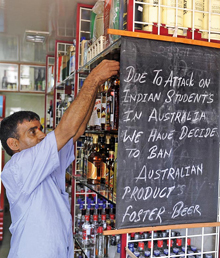Thuggery mars a burgeoning friendship
 Making a stand in Mumbai
Making a stand in MumbaiBELYING its name, Harris Park is neither leafy nor green. It is a gritty western Sydney suburb, where Indian students have recently taken to the streets in protest against some of the worst ethnic-based attacks Australia has seen. As young Indian men gather by the local railway station, police converge further down the street and arrest two non-Indians. Asked about the wave of violence against their community, two Indians lower their voices. “Lebanese,” says one. Others wonder if the answer may be more complicated.
The violence sprang to public notice when two Indian men were attacked with screwdrivers in Melbourne last month. One was robbed. Both ended up in hospital. A demonstration of about 2,000 Indian students in Melbourne called for stronger police action. They claimed the attacks fitted into a wider pattern of violence over the past year against Indians in Australia. The Melbourne attacks came as a firebomb was hurled in Harris Park through the window of a house where young Indians lived. One suffered bad burns. On June 8th two more Indians were attacked near a Harris Park restaurant, where Indian community leaders had gathered, prompting two successive nights of demonstrations in the suburb. The Indian press accused Australia of racism. Amitabh Bachchan, a Bollywood superstar, refused an honorary doctorate from a university in Brisbane.
Over the past 40 years Australia has received waves of immigrants from Vietnam, Lebanon and other parts of Asia and the Middle East. Most have settled peaceably. Indians are the latest to arrive. In the decade to 2006 the number of Australian residents born in India almost doubled. India was the third-fastest-growing source of immigrants, after New Zealand and China.
There has also been a big increase in students coming from India, especially in courses for skills where qualifications offer a fast track to permanent residency. Since 2006 Indian enrolments in such “vocational” courses jumped by 161%, reaching 52,000 last year. Many Indian students have fanned out from inner-city student quarters to private colleges in the suburbs, and to places like Harris Park where rents are cheaper, and crime rates higher. In recent years Indians have displaced Lebanese as the suburb’s biggest ethnic group.
Initially, police said the motive for the glut of attacks on Indians was robbery: students going home from night jobs carrying money and mobile phones were “soft” targets. Later, they conceded that some attacks were race-based. Many Indian students privately blame Lebanese youths, who may well be jobless gang-members. But at Billu’s Indian Eatery and Sweet House, a Harris Park gathering point, Aruna Chandrala, an Indian community leader, carefully avoids censure. “It’s a law-and-order issue,” she says. “The students are saying ‘Enough is enough’.”
It has also become a diplomatic embarrassment for Australia, at a time when it has been seeking to boost relations with India to what Stephen Smith, Australia’s foreign minister, calls “the front rank of our international partnerships”. Kumari Selja, India’s tourism minister, has cancelled a planned visit to Australia in July. And Manmohan Singh, the prime minister, has said he is “appalled” at the violence, calling some of it racially motivated.
Kevin Rudd, his Australian counterpart, dismissed race as a motive, and called the violence “just a regrettable fact of urban life”. About 20 Australians, he pointed out, had been assaulted or murdered in India over the past decade. That is a good debating point: but not one that will help persuade Indian parents that Australia is a safe place to send their children.
